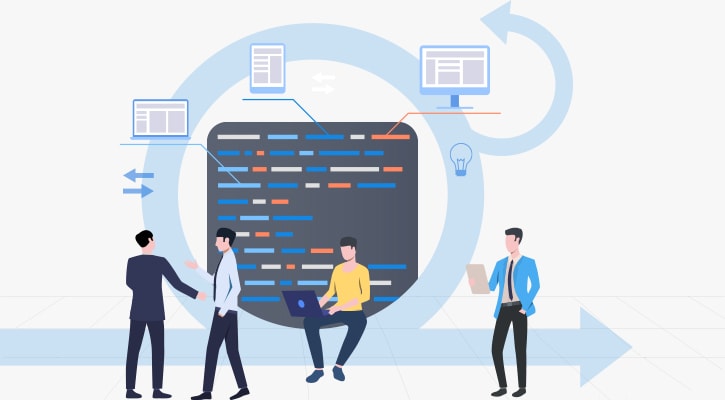Staff Augmentation vs Managed Services: Choose the best fit for your business


Employees are a crucial asset for any company. Nowadays, businesses have a more comprehensive range of options than before. Due to technology development and the widespread adoption of working remotely, they are no longer confined to hiring within their local area and can access a global talent pool.
Many businesses are opting to outsource essential tasks and project development. The global outsourcing market, valued at over $260 billion, is projected to grow significantly, potentially doubling by 2030.
There are different models of outsourcing, each offering its own set of advantages and challenges. We will compare staff augmentation vs. managed services to help you decide which is the best fit for your company.
Staff augmentation is a strategy where businesses hire external professionals temporarily to enhance their existing team’s capabilities. This approach enables access to local, nearby, and international expertise, allowing for team expansion or contraction.
In the IT sector, staff augmentation can be applied to various aspects of development, including coding, process improvement, and quality assurance or control. This method helps address specific challenges, fill skill gaps, adhere to budget and time limits, resolve technical issues, and speed up product release. It highlights the difference between managed services and staff augmentation, where the former offers a more comprehensive solution.

Staff Augmentation
This model is cost-efficient and offers flexibility for businesses. It serves as a short-term strategy that maximizes the use of current teams and resources while gaining the advantages of external expertise and lowering operational expenses.
As a business model, managed services refer to outsourcing specific operational tasks to an external entity, a Managed Services Provider (MSP). This model encompasses a wide range of services that a business might outsource, including but not limited to cybersecurity, data migration, database administration, and software development.
Managed service providers operate autonomously in this arrangement, distinct from the client’s in-house IT team. They present a project proposal detailing the costs and timeline to the client. They embark on the assigned tasks upon approval, maintaining ongoing communication with the client for updates and coordination.

Managed Services
The managed services model is recognized for its cost-effectiveness, primarily due to its ability to minimize overhead expenses, human resource-related tasks, and the intricacies of resource management. It allows a company to focus on its core business functions, relying on periodic updates from the MSP for progress checks rather than necessitating daily oversight of the outsourced tasks.
Learn more:
| Managed Services | Staff Augmentation | |
| Scope of Service | Outsourcing an entire function or department to a third-party provider. The service provider manages all aspects of the operation, including planning, implementation, and maintenance. It’s a comprehensive approach where the provider is responsible for the outcomes of the service. | In contrast, staff augmentation is about supplementing an organization’s existing staff with external personnel. This approach typically fills specific skill gaps or adds additional project resources. The augmented staff work under the organization’s management and direction. |
| Control and Oversight | The service provider has more control and autonomy in delivering services. The client sets the objectives and expectations, but the provider decides the best way to achieve them. | The client retains complete control and oversight of the project and its execution. Augmented staff integrate into the client’s existing teams and follow the client’s processes and guidelines. |
| Responsibility and Accountability | The managed service provider is accountable for the service’s performance and successful outcomes. They are responsible for meeting the agreed-upon service levels and performance metrics. | The client is responsible for the project’s overall success, including managing the augmented staff. The external personnel are responsible to the client for their performance. |
| Cost Structure | Typically involves a fixed cost or a subscription model, providing predictability in expenses. Prices are aligned with the services provided rather than the number of personnel. | Costs are usually based on the number of hours or days the augmented staff works. This model offers flexibility to scale up or down based on project needs. |
| Duration and Flexibility | Often used for long-term, ongoing needs. The approach could be more flexible regarding scaling the workforce up or down quickly. | More suitable for short-term projects or temporary needs. It offers high flexibility to adapt the workforce quickly based on the project’s evolving requirements. |
| Expertise and Specialization | Providers typically possess specialized skills and are tasked with keeping abreast of the most recent trends and technologies in their service area. | The client leverages specific skills of augmented staff but typically doesn’t expect them to drive innovation or strategic change. |
Choosing between the staff augmentation vs managed services model hinges on a thorough evaluation of your business requirements and a careful analysis of the advantages and disadvantages of each option. Both staff augmentation and managed services present distinct solutions to the challenges faced by companies. The ideal selection is influenced by various factors, including the length of the project, the degree of control needed, and specific business needs.
By considering these elements and examining each approach’s strengths and weaknesses, organizations can make a well-informed choice regarding the most suitable outsourcing strategy for their particular circumstances.
Companies must assess their specific needs, the project duration, and the level of control required when deciding between staff augmentation and managed services. A thorough understanding of your business needs involves considering the project’s scope, timeline, and available resources, including the involvement of a project manager.
Acknowledging these aspects enables organizations to choose the most fitting outsourcing model for their unique situation.
Please feel free to contact us for a free consultation: IT Staff Augmentation Services

Staff Augmentation VS. Managed Services
Understanding the pros and cons of each model is vital to making a well-informed decision about the most appropriate outsourcing strategy for a company’s unique context. Staff augmentation provides access to specialized talent, cost efficiency, and enhanced adaptability, which benefits short-term projects and variable workloads.
Conversely, managed services offer streamlined operations, heightened security, and continuous support and maintenance, making them preferable for organizations needing long-term assistance and expert advice.
By weighing each model’s cost, flexibility, and level of control, organizations can identify which outsourcing approach aligns best with their requirements and goals. This ensures optimal use of resources and achievement of project objectives.
In conclusion, when considering staff augmentation vs. managed services, the right choice depends on your unique business needs and project requirements. Staff augmentation offers flexibility for short-term, specialized needs, while managed services provide a comprehensive, long-term solution. To make an informed decision that aligns with your strategic goals and ensures successful project outcomes, it’s crucial to assess your specific situation carefully.
If you still need to decide which path to take, TECHVIFY is here to help. Our team of experts can help you through the decision-making process, ensuring you choose the best model for your business. Contact TECHVIFY today to explore how we can offer you the best services in staff augmentation and managed services tailored to your business needs. Let us help you make the right choice for your business’s future.


Table of ContentsI. Understanding Staff Augmentation vs Managed Services1. What is Staff Augmentation?2. What is Managed Services?II. The difference between Managed Services and Staff augmentationIII. Staff Augmentation vs. Managed Services: Making the Right DecisionConclusion Technological advancements are paving new paths for companies across different sectors, and the logistics industry is no exception. According to a survey by Gartner, 87% of supply chain professionals plan to invest in enhancing the resilience of their platforms. Logistics encompasses a broad and complex array of processes that demand the utmost precision and continuous optimization. Companies can automate and streamline these processes through software product…
26 July, 2024

Table of ContentsI. Understanding Staff Augmentation vs Managed Services1. What is Staff Augmentation?2. What is Managed Services?II. The difference between Managed Services and Staff augmentationIII. Staff Augmentation vs. Managed Services: Making the Right DecisionConclusion The technology sector is advancing at an unprecedented pace, and the HR landscape is evolving right alongside it. To attract top talent, HR professionals and organizations need to stay ahead of emerging technology hiring trends. This year, we are witnessing significant shifts in hiring practices that will redefine our understanding of the future workforce. According to a Microsoft study, the number of technology jobs worldwide is…
25 July, 2024

Table of ContentsI. Understanding Staff Augmentation vs Managed Services1. What is Staff Augmentation?2. What is Managed Services?II. The difference between Managed Services and Staff augmentationIII. Staff Augmentation vs. Managed Services: Making the Right DecisionConclusion Customized software plays a major role in managing various tasks within the telecom industry. It is essential for allocating numbers to subscribers and managing networks through optimized and AI-enabled routing protocols. Additionally, it aids in detecting fraud with intelligent telecom software development solutions and maintaining detailed subscriber profiles, including comprehensive call recording reports. I. A Quick Look into the Telecommunication Industry The telecommunications industry enables the…
24 July, 2024


Thank you for your interest in TECHVIFY Software.
Speed-up your projects with high skilled software engineers and developers.
By clicking the Submit button, I confirm that I have read and agree to our Privacy Policy